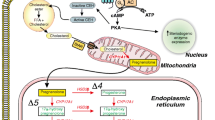Abstract
T acts as a vasodilator in vitro and in vivo. Supplemental T therapy in humans with angina improves symptoms and reduces objective measures of ischemia. In left anterior descending coronary arteries taken from adult male Wistar rats, T abolishes 100±4.2% of calcium-dependent contraction induced by potassium chloride, 82.3±6.1% of the mostly calcium-dependent contraction induced by prostaglandin-F-2-α, but only 45.3+_3.4% of the contraction induced by phorbol-12,13-dibutyrate (PDBu) in the presence of extracellular calcium, and 54.5±4.5% of the contraction induced by PDBu in the absence of extracellular calcium. These findings suggest that T is primarily inhibiting the calcium-dependent elements of vascular contraction.
Similar content being viewed by others
References
Yue P., Chatterjee M.B., Beale C., Poole-Wilson P.A., Collins P. Testosterone relaxes rabbit coronary arteries and aorta. Circulation 1995, 91: 1154–1160.
Chou T.M., Sudhir K., Hutchison S.J., et al. Testosterone induces dilation of canine coronary conductance and resistance arteries in vivo. Circulation 1996, 94: 2614–2619.
Webb C.M., McNeill J.G., Hayward C.S., de Zeigler D., Collins P. Effects of T on coronary vasomotor regulation in men with coronary heart disease. Circulation 1999, 100: 1690–1696.
Rosano G.M.C., Leonardo F., Pagnotta P., et al. Acute anti-ischaemic effect of testosterone in men with coronary artery disease. Circulation 1999, 99: 1666–1670.
English K.M., Steeds R.P., Diver M.J., Jones T.H., Channer K.S. Low dose transdermal testosterone therapy improves angina threshold in men with chronic stable angina. Circulation 2000, 102: 1906–1912.
Crews J., Khalil R.A. Gender specific inhibition of Ca entry mechanisms of arterial vasoconstriction by sex hormones. Clin. Exp. Pharmacol. Physiol. 1999, 26: 707–715.
Murphy J.G., Khalil R.A. Decreased [Ca2+] during inhibition of coronary smooth muscle contraction by 17β estradiol, progesterone and testosterone. J. Pharmacol. Exp. Ther. 1999, 291: 44–51.
Honda H., Unemoto T., Inoue K., Tamura K., Kogo H. Testosterone induced relaxation of aorta: Comparison of Wistar-Kyoto and spontaneously hypertensive rats. Arch. Pharmacol. 1998, 358: R253.
Mulvany M.J., Halpern W. Contractile properties of small arterial resistance vessels in spontaneously hypertensive and normotensive rats. Circ. Res. 1977, 41: 19–26.
Mori T., Yanagisawa T., Taira N. Phorbol 12,13-dibutyrate increases vascular tone but has a dual action on intracellular calcium levels in porcine coronary arteries Naunyn-Schmeidebergs Arch. Pharmacol. 1990, 341: 251–255.
Author information
Authors and Affiliations
Corresponding author
Rights and permissions
About this article
Cite this article
English, K.M., Jones, R.D., Jones, T.H. et al. Testosterone acts as a coronary vasodilator by a calcium antagonistic action. J Endocrinol Invest 25, 455–458 (2002). https://doi.org/10.1007/BF03344037
Accepted:
Published:
Issue Date:
DOI: https://doi.org/10.1007/BF03344037




